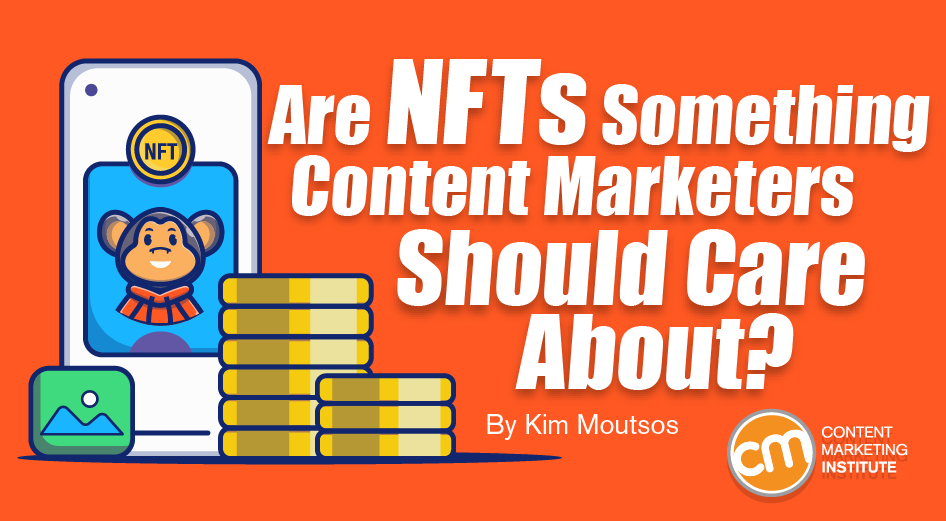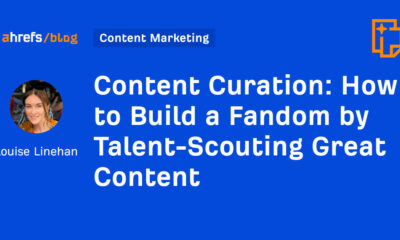MARKETING
Are NFTs Something Content Marketers Should Care About?

What’s your take on NFTs?
1. Yes, please.
2. Wait and see.
3. Pfft.
Brands like Gap, Coca-Cola, Adidas, Reebok, Lamborghini, and other consumer product companies would respond, “Yes, please,” as they have made splashy forays. News, sports, and entertainment brands have made moves, too.
If you haven’t gotten questions about how (or whether) your brand’s content strategy should include NFTs, it’s only a matter of time.
Before you answer the inevitable question, you should understand some NFT basics and know how they can be used.
Content strategist and comic book author Buddy Scalera offered a helpful introduction for content marketers in a recent episode of The Creative Show, which he hosts with CMI Creative Director Joseph (JK) Kalinowski.
Like many creatives, Buddy’s interest in the topic sprang from the news in 2021 that an NFT minted by Beeple sold for more than $69 million. Buddy researched, experimented, and eventually co-wrote a comic explaining how NFTs work.
I’ve recapped his answers to several NFT questions on content marketers’ minds (and supplemented some of his answers with additional information and resources). You can watch the full discussion:
What is an NFT?
NFT stands for non-fungible token. That clears everything up, doesn’t it? (No? Not for me, either.)
Wikipedia explains an NFT as “a non-interchangeable unit of data stored on a blockchain, a form of digital ledger, that can be sold and traded. Types of NFT data units may be associated with digital files such as photos, videos, and audio.”
Buddy helpfully likens an NFT to the deed to a house. Just as a deed proves you own the house, an NFT proves you own a digital asset.
@BuddyScalera likens an #NFT to a deed to a house. It proves you own a digital asset via @KMoutsos @CMIContent. Click To Tweet
Here’s where things get a little murky, though.
Owning an NFT doesn’t mean you own the copyright to the digital asset it’s associated with. It indicates you own the original digital asset. As NerdWallet explains, an NFT “essentially allows its buyer to say that they own the original copy of a digital file in the same way you might own the original copy of a piece of physical art or the master file of a music recording.”
Owning an #NFT doesn’t mean you own the copyright to the digital asset, says @KMoutsos via @CMIContent. Click To Tweet
The answers to what ownership rights come with an NFT purchase is evolving. Anyone considering creating, buying, or selling NFTs should study this closely (and, ideally, get good legal advice).
Can brands use NFTs for more than digital art?
NFTs for digital art, collectibles, and metaverse real estate or accessories, get plenty of public attention. But, a recent Harvard Business Review article suggests that brands focusing on using NFT collections to represent their physical products in the digital work (think NFTs for digital Nike sneakers) may miss the bigger opportunity.
Eventually, the article suggests, “NFTs could be the central digital touchpoint between brands and their consumers — and one that is controlled by the brand itself.” Instead of using NFTs for digital assets, brands could use them to identify unique experiences or objects in the physical world.
#NFTs could be the central digital touchpoint between brands and their consumers – one controlled by the brand, says @HarvardBiz via @KMoutsos @CMIContent. Click To Tweet
So-called “utility NFTs,” as Buddy explains, are NFTs that unlock something. Buddy points to Gary Vaynerchuk’s VeeFriends NFT project. Buying a VeeFriends NFT unlocks different functionality (e.g., a one-on-one coaching session with Gary, access to an exclusive part of his Discord community). In this case, buying the NFT is akin to purchasing a pass or ticket for some extra value.
In a brand scenario, the company would decide what that pass in the form of an NFT would unlock. It could be for something your business would ordinarily charge, like an extended warranty or an event experience. “You get this whole experiential marketing thing,” Buddy says.
One of the most visible NFT projects, Bored Ape Yacht Club, offers both a creative asset and utility in each token. Owners of Bored Ape NFTs can access a social club with benefits like a private Discord server where members can chat with other members.
Earlier this year, a free NFT collection for the Grammy Awards offered access to a private Discord channel. And one of the NFTs unlocked a “golden ticket,” which paid travel and lodging costs for the winner and a friend to go to the awards ceremony.
Should my brand’s content strategy include NFTs?
While you are the best person to know if your brand’s content strategy should include NFTs, Buddy suggests using the 3 Cs of content marketing to make your decision – content, community, and consistency.
Again, Buddy points to Gary Vaynerchuck, who has nurtured his community with consistent free content for a decade. When he dropped an NFT collection, his community was ready for it.
But brands will struggle with NFTs if they don’t pay attention to the fundamentals, JK cautions. That means educating the audience about the value your NFT project has to them and not just jumping on the bandwagon because other brands are doing it.
“We as brand stewards or consultants need to be honest and transparent with our brands,” Buddy explains. That means doing the hard work that goes into evaluating any content marketing initiative. Most of that work happens before you even start thinking about what kind of content (NFT or not) to create.
Buddy suggests asking these questions before delving into NFTs:
- How will an NFT project align with our business strategy?
- How will it align with our brand goals?
- Does it make sense for your customers or audience?
I’d add one more question: Does it align with what your brand stands for?
Patagonia probably won’t offer NFTs (or find success with them if they do) because of their commitment to environmental causes. The environmental impact of minting (i.e., creating) a typical NFT (and other blockchain assets) equals 500 miles of driving in a gasoline-powered car.
Salesforce learned the hard way about NFT alignment with brand values. A sustainably committed company, Salesforce found hundreds of its employees protesting its plans to create an “NFT cloud” where creators could mint and sell the tokens. The employees thought the environmental impact of NFTs conflicted with the company’s commitment to sustainability, which it had recently touted in an ad that ran during the Super Bowl.
What should I do about NFTs today?
What you should do today about NFTs really depends on your analysis of how (or whether) NFTs make sense for your audience and your brand. It’s the same advice you’ve heard about entering any trendy new initiatives.
If your audience consists of gamers, art collectors or enthusiasts, and people receptive to interacting with blockchain-related elements or hanging out in the metaverse, you might decide to move faster than someone whose audience feels less connected to those circles.
Use these early days to talk with stakeholders about how NFTs might fit with your brand strategy, positioning, and values. Talk with your audience and customers to gauge their level of interest in and openness to NFTs. If NFTs seem promising after those discussions, study up to decide your best way forward.
Bookmark these resources to help you on your way:
I’d love to hear what you think about NFTs. Are they a fit for your audience? Do you want to read more about brands using NFTs? What other NFT questions can we help you answer? Let me know in the comments.
Cover image by Joseph Kalinowski/Content Marketing Institute



















You must be logged in to post a comment Login